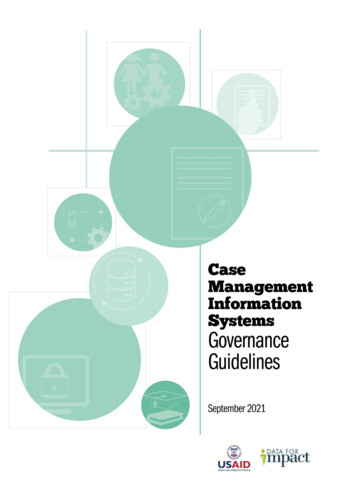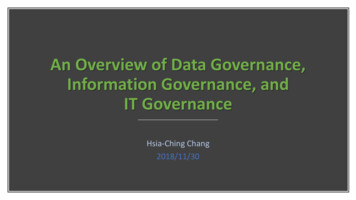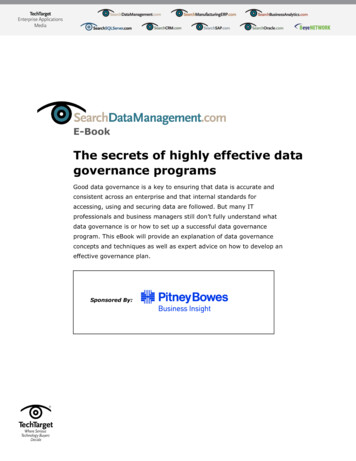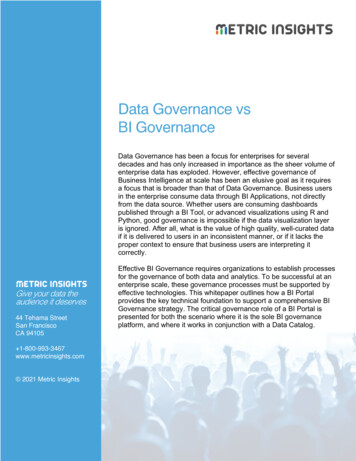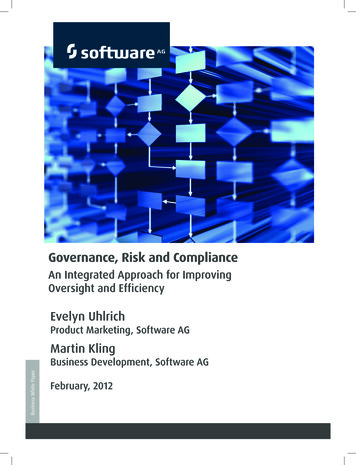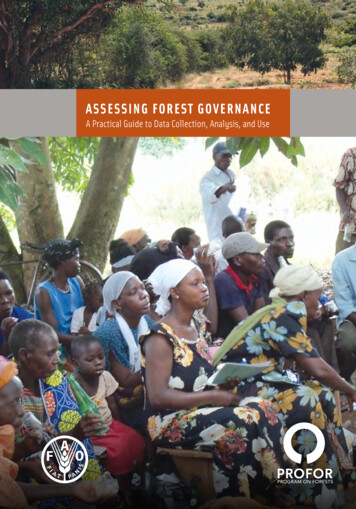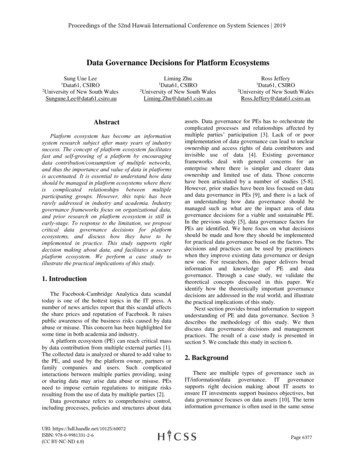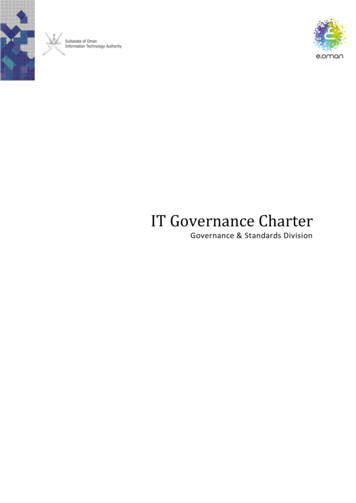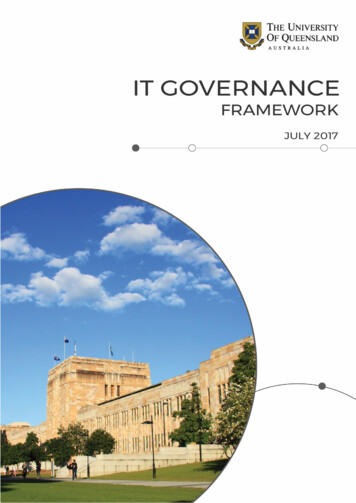
Transcription
Position and Communication Papers of the 16th Conference onDOI: 10.15439/2021F39Computer Science and Intelligence Systems pp. 183 190 ISSN 2300-5963 ACSIS, Vol. 26Assessing Enterprise Governance of Information TechnologyMaturity Models in Middle East and North Africa RegionMostafa M. AlShamy, Walid M. Abdelmoez,Essam Eldean ElfakharanyHany H. AmmarCollege of Computing and Information Technology,Arab Academy for Science, Technology and Maritime Transport, EgyptEmail: mostafa.alshamy@egybyte.net, uAbstract—Enterprise Governance of IT (EGIT) is an important topic for academics and practitioners in the context ofachieving enterprise goals while optimizing resource utilizationand risk management. EGIT is playing a critical role in developing countries as resources are rare and risk levels are higher.There is a need for EGIT Maturity Models (MMs) in MiddleEast and North Africa (MENA) region detected by deliveringand analyzing two questionnaires which were shared with agroup of participants working in the field. The obtained resultshave been generalized and consolidated into a generally applicable requirement list covering the specific needs of MENA region. The results of this paper reveal that although there aresome global EGIT MMs used in MENA region which coversome maturity dimensions, there is a lack of easy-to-use integrated multi-dimensional EGIT MMs specific for the regionneeds.I.INTRODUCTIONMATURITY Models (MMs) are techniques developedand used to determine the level of performance, capability or maturity of process or organization [1]. They areused to discover organizations strength and weakness pointsto enable them to define respective opportunities for improvement. They are also used to determine maturity targetsand how to reach them. We tried to get Middle East andNorth Africa (MENA) region respective stakeholders involved by developing and sharing two questionnaires toknow more about how their organizations select, use, and integrate Enterprise Governance of IT (EGIT) MMs. The analysis of these two questionnaires revealed a demand in theMENA region for having an EGIT MM with special characteristics covering the local needs and context.MENA region has some specific needs based on the nature of its member countries as they all are developing countries with emerging economies based on the natural and human resources they have and great opportunities for improvement. At the same time, the Arab Peninsula countriesare emerging with their eagerness to achieve great improvements over short times due to their new economic strategieswhich include many dimensions include information technology, cybersecurity, and data management among others.The region is starting to believe in the importance of corporate governance and EGIT in achieving the national and organizational goals and objectives effectively. Many counties 2021, PTI183Lane Department of ComputerScience and Electrical Engineering,West Virginia University, WV, USAEmail: hammar@wvu.edulike Egypt, Kingdom of Saudi Arabia (KSA), United ArabEmirates (UAE) among others begin to have strategic visionfor 2030 and many respective initiatives with clear goals,roles and responsibilities and actual measurement techniques.Organizations in MENA region are becoming more interested in EGIT as we discovered that around 80% of organizations are trying to implement or have already implementedan EGIT MM based on the conducted questionnaires. Thoseorganizations need a MM that can enable them to measuretheir EGIT maturity and guide them to improve their performance to achieve their goals and comply with emerging regulations while optimizing resources and risk. None of MMsexamined in this research uses stage-based and multi-dimensional maturity measurement methodology as they are justusing separate dimensions and maturity levels except forCOBIT 2019 [2] which uses different dimensions but doesnot have stage-based maturity measurement methodology.Therefore, these MMs enforce the interested organizationsto use more than one of them together. At the same time, tomeasure all respective processes/aspects of the organizationagainst each maturity level is specially considered huge effort for small and medium organizations. Therefore, manyorganizations cannot implement EGIT measurement and improvement easily due to the lack of a single easily integratedMM. We could not find any information about any EGITMM which was developed in or for the MENA region tocover its context and maturity level. Therefore, we will assess the MMs in MENA region and define the needs of itsorganizations.In this paper we present the result of assessing EGITMMs in the MENA region and the specific needs of organizations working in it which are interested in measuring andimproving their EGIT maturity. It should be noted thatEGIT here has governance stands for Governance, Risk andCompliance (GRC) combined. We aim to define the needsof the organizations working in the MENA region to knowif there is a need for a new EGIT MM, or the existing MMsare effective and efficient. If a new EGIT MM is needed, wetarget to identify its characteristics to guide researchers whomay be interested in developing one. The objective is to design questionnaires to cover EGIT management and usage
184POSITION AND COMMUNICATION PAPERS OF THE FEDCSIS. ONLINE, 2021and provide them to respective representatives from someorganizations working in different fields and representingdifferent sized organizations. Their answers will be analyzedproperly. This will lead us to know the MENA region EGITMM needs and customization.This paper is organized as the following. Section 2 coversthe literature review. Section 3 covers assessingorganizations using EGIT MM in the MENA. Section 4covers conclusions and future work.While maturity itself is defined by Rosemann and deBruin [3] as “a measure to evaluate the capabilities of anorganisation in regard to a certain discipline”, Becker et al[1] define MM as “conceptual models that outlineanticipated, typical, logical, and desired evolution pathstowards maturity”. They are also used to determine maturitytargets and how to reach them. MMs can have three purposes[3]: Descriptive which measures the current state (AS-IS) ofan entity, Prescriptive which determines the desired state (TOBE) of an entity and Comparative which allows entities to benchmark.Descriptive MMs measures the current existing maturitylevels in organization against predefined maturity levels toenable organizations to know their actual achievements. Thisenables organizations to understand their capabilities andweaknesses based on neutral assessment and analysistechniques.Prescriptive MMs enable organizations to determinewhich future maturity level suites their goals and objectivesthat can be achievable too. They help organizations indefining maturity targets to follow by initiating improvementinitiatives and assign needed competent resources.Comparative MMs enable different organizations tocompare their maturity achievements in a benchmark style. Itis a great type of MMs, but it needs many arrangements toguarantee its effectiveness and efficiency. It enablesorganizations to rank their maturity in a specific market orfield. Participating organizations must accept to sharespecific information with other entities including the otherparticipating organizations to enable the MM to measure theactual maturity level and there shall be an external neutralassessor to manage the whole process professionally.II. LITERATURE REVIEWThere are more than 150 MMs developed and published inthe last few years as stated by de Bruin et al. [3] to supportIT management. and in a research conducted by Becker et al[1] they found more than one thousand academic articlesprobably dealing with MMs published during the period of1994 to 2009 when they applied a maturity model keywordsearch in ten scientific databases. When they tried to extendtheir analysis in 19 pure IS journals their search resulted in20 articles that focus on MM. They discovered that there isno clear guidance on how to develop a MM using a scientificmethodology. Becker’s procedure model [4] is consideredthe greatest source of guidance for developing any EGITMM due to the simple and scientific eight requirementsprovided.We conducted a search for Maturity Model and ITGovernance Maturity Model key words in three majorpublishers indexed in Scopus with good Cite Score which areIEEE, Springer Nature and Elsevier. The search coveredMM in two geographical locations which are worldwide andMENA region. The result of the search is depicted in Table1. There are no IT Governance MMs in the MENA regionbased on IEEE and Elsevier while there is a few found onSpringer Nature. After examining those found on SpringerNature, we found them not related to IT Governance by anymeans.The existent MMs are belonging to one of two differentapproaches, the first one of them is the commercial approachwhich is based on the efforts of big service providers andbodies of knowledge. The other approach is the academicone with many researchers who attempted to develop MMswhile they do not have enough resources and capabilities likethe first approach. This part will cover the existent MMs andcompare among them.Although there are many existing MMs in the field ofinformation and technology, all of them lack one or moreneeded EGIT dimensions and some of them are not targetingEGIT. There is a need to assess the existing MMs from theorganizations and stakeholders’ perspectives. Therefore, wedeveloped and shared two questionnaires to collect andanalyze stakeholders’ feedback to have general overview ofthe current situation of EGIT MMs in the MENA region.The need for a new MM with specific characteristics whichsuite more organizations in the region has be detected.A. Maturity Models ClassificationThe first approach which is commercial EGIT MMs willbe covered here by three of the most famousmaturity/capability models in the market and two ISOTABLE 1.MM AND IT GOVERNANCE MM IN LEADING SCIENTIFIC JOURNALS.Search KeywordIEEEElsevierSpringer 65N/A27,452N/A7,11539IT Governance MM86N/A340N/A713
MOSTAFA ALSHAMY ET AL.: ASSESSING ENTERPRISE GOVERNANCE OF INFORMATION TECHNOLOGY MATURITY MODELSstandard which many companies were trying to use to knowtheir maturity level and how to improve it. IT InfrastructureLibrary (ITIL) framework [5] is considered the most famouspublic framework for IT Service Management (ITSM) forthe last thirty years and it has so many practitioners in theMENA who have attended its training courses and tookcertification exams. It has a lifecycle for any IT servicewhich includes five stages empowered by twenty-sixprocesses, four main IT functions and many techniques formanaging IT services and increasing the customersatisfaction in a measurable manner. ITIL v3 and its 2011update included a MM called Process Maturity Framework(PMF) [5] which is an easy-to-use multi-purpose ITSM MMthat measures the maturity of ITSM processes using fivematurity levels from 1 to 5 which are called initial;repeatable; Defined; Managed and Optimizing. Each levelmeasures five areas which are considered dimensions andthey are Vision and steering; Process; People; Technologyand Culture. It is an ITSM MM while it can be used tomeasure any other domain. It assesses all the processesagainst each maturity level.Control Objectives for Information and RelatedTechnology (COBIT 5) [6] was considered the most famouspublic framework for Governance of Enterprise Informationand Related Technology from 2012 to 2018 when it was replaced by COBIT 2019, and it has a Process CapabilityModel [7]. It has many practitioners in the MENA who haveattended its training courses and took certification exams. Itdifferentiated between governance and management and theprocesses of each. It was created based on other bestpractices which are governance principles from ISO/IEC38500 [8], risk management from ISO 31000 [9], enterprisearchitecture from TOGAF [10], project managementmethodology from PRINCE2 [11] and PMBOK [12],information security management from ISO/IEC 27001 [13],application capability measurement from CMMI [14], ITservice management processes from ITIL 2011 [4] andISO/IEC 20000 [15]. COBIT5 has thirty-two managementprocesses in four domains and five governance processes inone domain. COBIT5 has capability model called ProcessCapability Model which is built on the internationallyrecognized ISO/IEC 15504-2 standard [16] for SoftwareEngineering - Process Assessment standard. ISACA which isthe owner and developer of COBIT5 refuses to use the termmaturity as it assumed that maturity can be used formeasuring many dimensions of an organization and not onlyone as COBIT5 which was just measuring processes, so itwill be reasonable to use capability instead of maturity. Itmeasures the capability of IT governance and managementprocesses using six capability levels from 0 to 5 which areIncomplete Process; Performed Process; Managed Process;Established Process; Predictable Process and OptimisingProcess. Each capability level has four ratings which areFully ( 85 % to 100 % achievement), Largely ( 50 % to85% achievement), Partially ( 15 % to 50 % achievement)and Not achieved (0 to 15 % achievement). It has nineattributes within the second to the sixth capability levels. Theattributes found in a specific capability level shall be fullyachieved so that the assessment can go for the next level. It isnot an easy-to-use multi-purpose EGIT MM for MENA asmany organizations do not have many of its processes and donot have enough resources to conduct its complexassessment. COBIT5 has only one dimension which isProcess and therefore it measures capability and notmaturity, other dimensions are still needed like informationsecurity, business continuity and compliance. It assesses allthe processes against each maturity level and a simplerversion tailored for the needs of MENA region is needed tocover its specific needs.COBIT 2019 [2] is the new version of COBIT5 which wasreleased by ISACA at the end of 2018. Now it has moreprocesses as it has 35 processes for IT Service Managementand 5 processes for Governance. It is not an easy-to-usemulti-purpose EGIT MM [17]. It uses CMMI Development 2.0 [14] process capability scheme. It has fourdimensions which are Process, Organizational Structures,Information Items and Culture and Behavior. It has the samesix maturity levels and four ratings like COBIT5. It is noteasy to be used as it has six maturity levels including nineattributes and four ratings per each. It needs training,experience, and more resources to be implemented. It coversfour dimensions, and therefore it measures capability foreach dimension and maturity for all of them combined. Itcovers ITSM, information security, continuity, andcompliance as processes and not as dimensions. It assessesall the processes against each maturity level.ISO/IEC 15504-2 [16] is a guidance ISO standard createdfor process improvement and process capabilitydetermination. It is not an easy-to-use multi-purpose processMM. It has only one dimension which is Process. It has sixcapability levels which are Incomplete, Performed,Managed, Established, Predictable and Optimizing. It hasnine attributes covering the second to the sixth capabilitylevels. It is dedicated to process measurement and providedan exemplar software life cycle process assessment model. Itis not easy to be used in MENA region due to its complexityand resource consuming style. It needs training andexperience to be implemented. It covers one dimension,which is process, and therefore it measures capability andnot maturity, other dimensions are still needed. It assesses allthe processes against each maturity level.ISO 19600 [18] is a guidance ISO standard published in2014 and was created to provide organizations with guidanceon how to comply with regulations and avoid fines by havinga compliance management system. It is not a MM norprovides a maturity measurement like the other MMsmentioned above. Like many ISO standards it can measurecompliance to its requirements by having one of two stateswhich are conformity or non-conformity. It has only onedimension which is compliance which was missing in all theother mentioned MMs except for COBIT. It could be easy tobe used in MENA region due to its straightforwardrequirements and maturity measurement technique and theincreasing number of emerging regulations in the region. Itcovers one dimension and therefore other dimensions are185
186POSITION AND COMMUNICATION PAPERS OF THE FEDCSIS. ONLINE, 2021still needed. It was replaced by ISO 37301 [19] which wasreleased in 2021.For MENA region, ITIL is considered the best one forITSM while COBIT is considered the best one for EGIT.But they still need to be customized to cover MENA regionspecific requirements.The second approach covers relevant academicgovernance of IT maturity/capability models that representresearchers’ participation which does not reach to properaudience in many cases. Although, de Bruin stated that thereare more than 150 MMs in the last few years, the relatedwork here represents the most related MMs or theirdevelopment guidance. The related works can be dividedinto three categories which are the first category proposingMMs, the second category comparing among the developedMMs and the third category providing guidance on how todevelop a scientific MM.GoCoMM: A Governance and Compliance MaturityModel [17] by G. Gheorghe et al, Toward an IT GovernanceMaturity self-assessment Model Using EFQM and CobiT[20] by S. Arezki et al, Maturity Model Architect A Tool forMaturity Assessment Support [21] by Diogo Proença et al,Using Enterprise Architecture Model Analysis andDescription Logics for Maturity Assessment [22] by D.Proença et al, Software process improvement and capabilitydetermination [23] by A. Mas et al and An Overview of theBusiness Process Maturity Model (BPMM) [24] by JihyunLee et al, are representing the first category which proposeMMs. All these researchers tried to develop and propose aMM related to one aspect or more of EGIT.Comparing among the developed MMs which is thesecond category is represented by MATURITY MODELSIN IS RESEARCH [1] by J. Becker et al, The MaturityModels for Information Systems - A State of the Art [25] byD. Proença et al and Understanding maturity models Resultsof a Structured Content Analysis [26] by Kohlegger, M.,Maier, R., & Thalmann, S. The researchers are comparingamong a group of proposed and released MMs and trying todiscover their respective shortcomings.Providing guidance on how to develop a scientific MMwhich is the third category is represented by InformationGovernance Maturity Model - Final Development Iteration[27] by Proença et al, What makes a useful maturity model?a framework of general design principles for maturitymodels and its demonstration in business processmanagement [28] by J. Pöppelbuß et al, Maturity assessmentmodels: a design science research approach [29] by T.Mettler et al and Developing Maturity Models for ITManagement – A Procedure Model and its Application [30]by J. Becker et al, Assessing Organizational Capabilities:Reviewing and Guiding the Development of Maturity Grids[31] by Anja M. Maier et al, What Makes A Useful MaturityModel? A Framework Of General Design Principles ForMaturity Models And Its Demonstration In Business ProcessManagement [32] by Jens Pöppelbuß and MaximilianRöglinger, IT Evaluation in Business Groups: A MaturityModel [33] by Hamel, F., Ph, T., Falk, H., & Walter, U,Understanding the Main Phases of Developing a MaturityAssessment Model, (December) [34] by Bruin, T. De,Freeze, R., & Rosemann, M and A Design Science ResearchPerspective on Maturity Models in Information Systems[35] by Mettler, T. In this category researchers tried toprovide other researchers who are interested in developingMMs with guidance on how to develop and evaluate MMsproperly.Although the first category which proposes new MMs andthe second category which compares among the alreadydeveloped MMs are important, the last category which isproviding guidance on how to develop a MM is veryimportant as we will use its provided guidance inunderstanding how to develop a scientific MM if needed forthe MENA region. The following Table 2 gives a summaryof the covered dimensions of the MMs used in the marketTABLE 2.MM COMPONENTS COVERED BY EXISTING MMS AND ISO STANDARDS.ReferencesITIL PMFCOBIT ***ComplianceProcess*******ISO/IEC 15504-2PeopleTechnology*M o R MMP3M3 MMISO/IEC 20000-1:2018ISO/IEC 27001:2013ISO 2230-1:2019ISO d an IT Governance Maturityself-assessment Model UsingEFQM and CobiTMaturity Model Architect A Toolfor Maturity Assessment SupportUsing Enterprise ArchitectureModel Analysis and DescriptionLogics for Maturity AssessmentA Formalization of the ISO/IEC15504 Enabling AutomaticInference of Capability Levels****
MOSTAFA ALSHAMY ET AL.: ASSESSING ENTERPRISE GOVERNANCE OF INFORMATION TECHNOLOGY MATURITY MODELS187TABLE 3.EXISTING MMS AND ISO STANDARDS FEATURES AND MAIN AREAS OF APPLICATION IN ORGANIZATIONS.ReferencesITIL PMFFeaturesPublic/ProprietaryEasy to useDescriptive (D)/prescriptive (P)/comparative (C)Main Areas ofApplicationPublicYes(D)/(P)/(C)ITSMCOBIT 5/2019PublicNo(D)/(P)/(C)EGITISO/IEC 15504-2PublicNo(D)/(P)/(C)Process MeasurementM o R MMPublicYes(D)/(P)/(C)Risk ManagementP3M3 MMPublicYes(D)/(P)/(C)Portfolio, Program, andProject ManagementMaturity ModelISO/IEC 20000-1:2018PublicYes(D)/(P)/(C)ITSMISO/IEC 27001:2013PublicYes(D)/(P)/(C)Information SecurityISO 2230-1:2019PublicYes(D)/(P)/(C)Business ContinuityISO eManagementwhether they are commercial or academic to depict thedifferences among them. It will start with the commercialMMs and then the academic MMs. No MM covers all EGITdimensions with stage-based maturity levels.Table 3 covers the most famous MMs used currently inthe market and all of them are not academic ones. Itcompares among these MMs based on their features andmain areas of application in organizations. The features showwhether they are public or proprietary, ease of use andwhether they are descriptive, prescriptive, or comparative.B. MENA Region EvaluationWe searched Elsevier, IEEE and Springer Nature forMENA EGIT MM and we could not find any MMs whichwere developed in MENA region or specially developed forit. Although we have many EGIT MMs and regulationsdeveloped out of MENA region and used worldwide, we canfind only regulations developed and enforced in the MENAregion. These regulations are like Saudi NationalCybersecurity Authority (NCA) cybersecurity controls andSAMA business continuity management and cybersecurityframeworks in the Kingdom of Saudi Arabia or the EgyptianPersonal Information Protection Act among others. Wecould not find any EGIT MMs developed in or for MENAregion that care about its context and special needs.III. ASSESSING ORGANIZATIONS USING EGIT MM IN THEMENA REGIONThe study aims to understand the existing EGIT MMs inthe MENA region which should enable organizations toimprove their enterprise governance of IT in an easy andaffordable manner while helping them to comply withemerging regulations. The quantitative approach is used inthis research by developing and distributing twoquestionnaires, which were developed and published usingGoogle Docs, to 118 participants who are working in EGITand related functions including IT, Information Security,GRC, QA, Business Analysis, IT Service Management, ITProject Management, Infrastructure, IT Networks, ITOperations, Performance Management and Audit. The firstquestionnaire [36], which was published in 2019, asks theparticipants about their organizations’ behavior regardingEGIT using eighteen questions while the second one [37],which was published after a few months in 2020, asks themabout their organizations’ behavior towards EGIT andregulations using thirty questions. The number ofparticipants in the first questionnaire is eighty-three and thenumber of the second questionnaire participants is thirty-fiveand they provided valuable feedback which enriched ourresearch with market needs. The first questionnaire isdedicated to EGIT MMs while the second one isconcentrating on compliance MMs in addition to EGITMMs. The number of participants in the secondquestionnaire is less than of those of the first one as thenumber of those who are interested in compliance is less thanthe number of those who are generally interested in EGIT.The participants of the two questionnaires are working inmicro, small, medium, and large enterprises operating inEgypt, Saudi Arabia, UAE, Sudan, Jordan, Yemen, amongother countries in MENA.The main objective of these two questionnaires is todefine how organizations in the MENA region manage theEGIT maturity measurement using MMs. Both are structuredquestionnaires with a group of sequence questions leadingthe participants to describe how their organizations measuretheir EGIT maturity levels by using MMs. They start withasking the participants about their organizations type, size,location, and sector in addition to the position ofparticipants. Then, a group of multiple-choice questions isprovided to participants with the ability to choose one ormore options that match their environment.
188POSITION AND COMMUNICATION PAPERS OF THE FEDCSIS. ONLINE, 2021The two questionnaires were trying to get answers forquestions like: Whether organizations define and internally publish theirstrategies, goals, applicable regulations, and the implicationsof not complying with them? Whether organizations define their EGIT goals and mapthem to applicable regulations with respective annualimprovement initiatives and how to measure theirachievements? Whether organizations measure the maturity of their EGITand how? Whether organizations use one or more MMs to measurethe maturity of their EGIT and for which purpose(Comparative, Prescriptive and Comparative)? The ease of use of the used MMs and cost ofimplementation in addition to the need for professionaltraining? Whether the used MMs are scientifically developed, andwhich dimensions are included? The first-, second- and third-party assessmentsapplicability of the used MMs and the type of assessors? The preferred EGIT MM dimensions and language? The need for one integrated MM or different ones tomeasure organizations’ EGIT maturity and compliance torespective regulations?The results gained after analyzing the answers ofparticipants confirmed our point of view that MENA regionneeds an easy-to-use integrated multi-dimensional EGITMM that suites the specific context of the region.Table 4 gives a small set of the most important preferencesof users of the MMs that depict the characteristics of theMMs used in MENA market based on the answers of thefirst questionnaire participants. It is clear that some of theparticipants’ organizations just measure the achievement ofgoals and objectives instead of using market well-knownMMs. About third of the participants confirmed that they usemore than one MM while half of participants stated that theused MMs are developed using a scientific methodology andare easy to be used. More than half of the participantsconfirmed that they use MMs for descriptive, prescriptive, orcomparative purposes, while a higher percentage ofparticipants stated that they need training to implement theseMMs. Some of the participants stated that their MMs areexpensive. Few participants stated that their MMs are easy toTABLE 4.CHARACTERISTICS AND TYPES OF MMS IN MENA REGION BASEDSTON 1 QUESTIONNAIRE.AspectOrganizations use market well knownMMsOrganizations just measuregoals/objectivesbe used for a self-assessment.These statistics show that MENA market needs to have ascientifically developed EGIT MM that integrates othermarket well-known MMs while having descriptive,prescriptive, and comparative purposes. It should be easy-tounderstand and easy-to-use. If the MM will be publicly free,it will increase the number of its users and specially theorganizations which do not have enough resources. Theanalysis of the first questionnaire also depicts the needs ofMENA market for all types of MMs and if there is one MMcovering First, Second and Third-party assessments it willcover different segments of organizations. Self-assessmentand easy-to-use capabilities are also needed to enable smallorganization to measure their EGIT too.Table 5 gives a summary of the dimensions of the MMsused in MENA region based on the answers of the firstquestionnaire participants. Not less than half of theparticipants confirmed that their organizations have one ormore of the measured dimensions in their used EGIT MMs.Based on their use, the dimensions are ordered in adescending manner from Process, Technology, Risk,Projects, Programs, and Portfolio, collectively, Compliance,Management Commitment to People.All the provided percentages show big demand for allthese EGIT dimensions in MENA region, and it will be greathaving them combined in just one integrated MM.Table 6 gives a summary of the preferences of the users ofthe existing MMs in MENA market based on the answers ofthe second questionnaire participants. A high percentage ofparticipants stated that their organizations need to use MMfor measuring EGIT and compliance and more than half ofparticipants preferred to use one integrated MM instead ofusing many MMs in addition to the ability of having internaland external assessors. This means that there is a big needfor an integrated EGIT MM which can be used by internaland external assessors.Based on the analysis of the second questionnaire, Table 6gives a summary of how the organizations started to defineapplicable regulations and measure their compli
Governance Maturity Model key words in three major publishers indexed in Scopus with good Cite Score which are IEEE, Springer Nature and Elsevier. The search covered MM in two geographical locations which are worldwide and MENA region. The result of the search is depicted in Table 1. There are no IT Governance MMs in the MENA region

